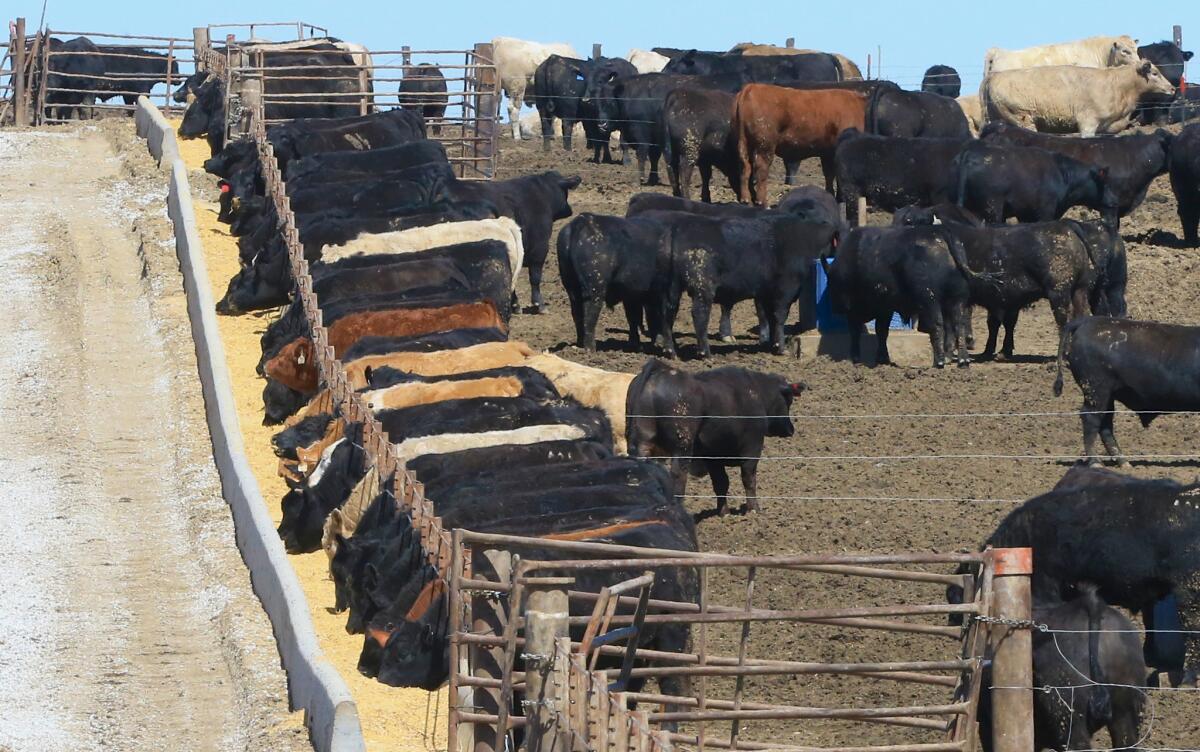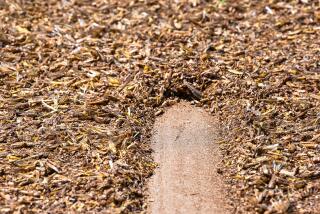Op-Ed: If we’re going to eat cattle, let them eat grass

- Share via
Stories about impending environmental apocalypse circulate almost daily, especially in drought-ravaged California. Many of these stories tend to blame agriculture — and specifically, beef — for gobbling up our resources. Though numbers vary widely and are hotly contested, some researchers estimate that it takes 1,800 gallons of water to produce each pound of beef.
The real problem, however, isn’t cattle. It’s industrial feedlots, where more than 70% of U.S. cattle eventually live.
In an industrial feedlot, potentially thousands of animals are packed together in an enclosure of bare, unproductive dirt. Nothing grows there. Operators have to bring in water for the cattle to drink, and for the enormous manure ponds that contain the cattle’s waste. But the majority of the water used in raising industrial cattle goes into growing their feed. These operations are tremendously resource-intensive.
If you eat beef, grass-fed cattle are a better option. Those cattle are a healthy part of a larger ecosystem.
Raised where grass grows, these cattle don’t need manure ponds. While they do need a source of drinking water, a rain-fed pond suffices in most cases. In turn, the animals’ grazing improves the health of the grassland, often dramatically, and increases the ecosystem’s water retention.
These cattle, moreover, can graze on marginal land that doesn’t have any other agricultural worth.
Several years ago, I purchased an entire grass-fed steer to feed my family. It was raised in an olive orchard, eating what the ranch considered “waste product”: the grass and scrub that grew between the olive trees.
Raising cattle for food isn’t necessarily incompatible with environmentalist or humanitarian agendas. Because cattle can thrive on otherwise unproductive land, the charity Heifer International provides livestock as a sustainable gift to poor families, mostly in the Third World.
Further, recent research suggests that properly managed grass-fed cattle can help capture and store carbon in grassland soil. In addition to making the soil more nutrient rich and better able to hold water, one study found this process happening at a rate that could actually help offset the rise in atmospheric carbon dioxide. It also showed that properly managed cattle pastures had levels of soil organic matter comparable with those of native forests.
Of course, if there isn’t enough rain for very much grass, there isn’t enough rain for very many grass-fed cattle. That’s where we are now in California.
In times like these, efficiency is paramount. And the most efficient way to use beef is to buy in bulk, up to and including an entire animal. The single steer I purchased lasted my family for nearly five years. I brought home every bit of the beast and used it all. I probably ate less beef per week than the typical consumer because I was trying to make the best use of every morsel.
According to the U. S. Department of Agriculture, Americans waste an estimated 30% of the food we produce. Reducing that percentage would greatly increase the efficient use of natural resources, including water.
Faced with the harsh long-term realities of climate change and the immediacy of the California drought, the choice is clear: If we’re going to eat cattle, let them eat grass.
Jared Stone is the author of “Year of the Cow: How 420 Pounds of Beef Built a Better Life for One American Family,” and a television producer in Los Angeles.
Follow the Opinion section on Twitter @latimesopinion and Facebook
More to Read
A cure for the common opinion
Get thought-provoking perspectives with our weekly newsletter.
You may occasionally receive promotional content from the Los Angeles Times.









